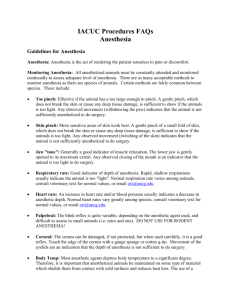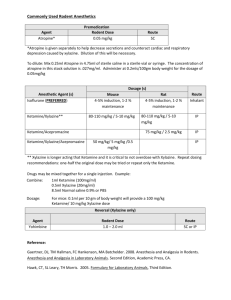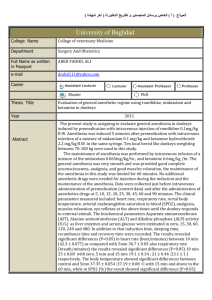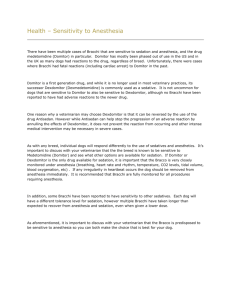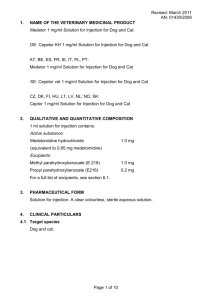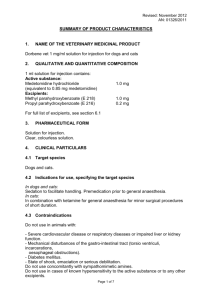Name:
advertisement
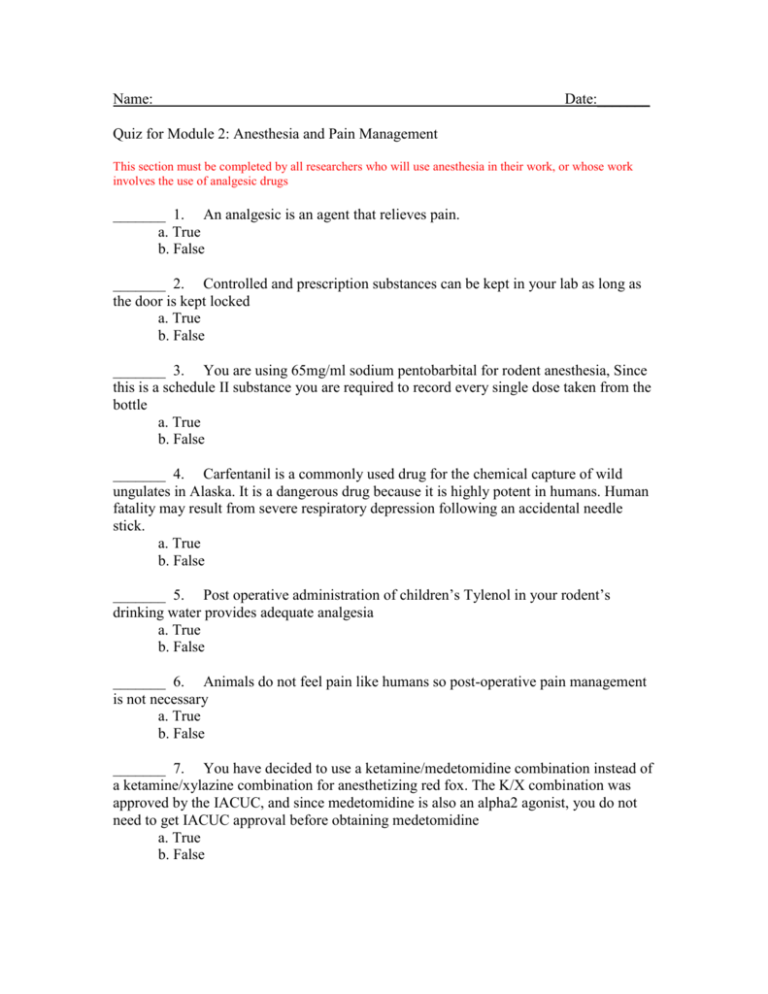
Name: Date:_______ Quiz for Module 2: Anesthesia and Pain Management This section must be completed by all researchers who will use anesthesia in their work, or whose work involves the use of analgesic drugs _______ 1. An analgesic is an agent that relieves pain. a. True b. False _______ 2. Controlled and prescription substances can be kept in your lab as long as the door is kept locked a. True b. False _______ 3. You are using 65mg/ml sodium pentobarbital for rodent anesthesia, Since this is a schedule II substance you are required to record every single dose taken from the bottle a. True b. False _______ 4. Carfentanil is a commonly used drug for the chemical capture of wild ungulates in Alaska. It is a dangerous drug because it is highly potent in humans. Human fatality may result from severe respiratory depression following an accidental needle stick. a. True b. False _______ 5. Post operative administration of children’s Tylenol in your rodent’s drinking water provides adequate analgesia a. True b. False _______ 6. Animals do not feel pain like humans so post-operative pain management is not necessary a. True b. False _______ 7. You have decided to use a ketamine/medetomidine combination instead of a ketamine/xylazine combination for anesthetizing red fox. The K/X combination was approved by the IACUC, and since medetomidine is also an alpha2 agonist, you do not need to get IACUC approval before obtaining medetomidine a. True b. False _______ 8. Since methoxyflurane is no longer available in the USA you can easily substitute halothane or isoflurane and follow the same procedures for induction and maintenance of anesthesia using the open drop or cone method a. True b. False _______ 9. You have been capturing Canada geese and anesthetizing them with ketamine /xylazine. During a lunch break you accidentally leave the drugs on the dash of your truck where they get rather hot. You let them cool back off, and continue using them for anesthetizing the birds a. True b. False _______ 10. The IACUC and attending veterinarian want you to use butorphanol as an analgesic in your study. However, you have information form a colleague that using an opiod might affect the outcome of your research. If you present this information to the IACUC, they will allow you to use a different analgesic a. True b. False _______ 11. You have checked the literature, your colleagues, and the attending veterinarian for the appropriate dose and route of administration for the drug you want to use for anesthesia of your research animals. Everybody you have talked to says the drug is safe and reliable, so it is unnecessary for you to read about the drugs basic pharmacology. a. True b. False _______ 12. Diazepam can be pulled into a syringe and, if not used immediately, left in the syringe. a. True b. False _______ 13. The action of opiod agonists like carfentanil or morphine are antagonized by opiod antagonists like naltrexone and naloxone. Likewise the action of alpha 2 agonists like xylazine and medetomidine are antagonized by alpha 2 antagonists like atipameole, tolazoline, and yohimbine. The mechanism of antagonism is by competitive binding for specific receptors a. True b. False _______ 14. The anatomy of the lungs and air sacs in birds makes gas anesthesia of birds different from that of mammals a. True b. False _______ 15. The drugs phencyclidine, ketamine, and tiletamine a. produce a state of anesthesia termed dissociative anesthesia b. are frequently combined with a sedative or tranquilizer to reduce undesirable side effects c. are all still available for use on animals d. produce excellent muscle relaxation e. A and B Only f. A, B, and C _______ 16. The most potent analgesics are in what class of drugs a. Narcotics (opioids) b. Barbiturates c. Alpha 2 agonists d. Cyclohexamines e. B and C f. None of the above _______ 17. Catalepsy is a. Characterized by a trance like state and constantly maintained immobility, usually with rigidity b. Is produced in many species by cyclohexamines when administered along c. Is a characteristic of profound analgesia d. Is an indication of deep anesthesia e. All of the above f. A and B only g. None of the above _______ 18. Diazepam is a. A tranquilizer b. A drug that is easily absorbed following IM injection c. May cause convulsions d. A potent analgesic e. A and B only f. None of the above _______ 19. The ketamine you have for your animal anesthesia expired 2 months ago. You should a. Properly dispose of the ketamine b. Proceed with your planned anesthesia since the drug should still be effective c. Toss it in the trash _______ 20. Pre-anesthetic medication might include administration of a. A tranquilizer or sedative b. A parasympatholytic agent like atropine c. An antibiotic if needed for prophylaxis d. All of the above e. A and C only _______ 21. To anesthetize a mouse you are going to give medetomidine (1mg/kg) and ketamine (75mg/kg). Medetomidine is available at 1 mg/ml and ketamine is available at 100mg/ml. What volume of these drugs will you administer to a 10g mouse? a. 0.1 ml medetomidine and 0.075ml of ketamine b. 0.01 ml medetomidine and 0.0075ml of ketamine c. 0.01 ml medetomidine and 0.075ml of ketamine d. 0.01 ml medetomidine and 0.00075 ml of ketamine e. None of the above _______ 22. The volume of drug required to anesthetize the mouse in the previous question is too small for practical use. Therefore to administer such a tiny quantity to such a small animal, you must a. Plan a project using a larger animal b.Obtain lower concentration formulations of the drugs from colleagues in Europe c. Pepare a diluted mixture using commercially available sterile water for injection d. Pepare a diluted mixture using sterile water e. Either C or D _______ 23. Minimal anesthesia monitoring includes a. Taking a rectal temperature every 5-10 minutes b. Taking heart rate every 5-10 minutes c. Taking respiratory rate every 5-10 minutes d. Regularly checking the animals capillary refill time and assessing color of mucous membranes e. All of the above f. A and C only g. A, B, and C only _______ 24. When anesthetizing animals, a parasympathetic agent like atropine or glycopyrolate is often used to a. Increase the potency of the anesthetic agent b. Reduce bronchial secretions c. Dilate the pupil d. Protect the heart e. B and D only f. All of the above _______ 25. The alpha 2 agonist xylazine is a very commonly used sedative in research on captive and free ranging animals. However, it has some undesirable side effects, including a. It can markedly reduce heart rate and blood pressure b. It causes muscle rigidity c. It can reduce gastrointestinal motility which can lead to bloat in ruminants d. It can affect thermoregulation e. All of the above f. A, C, and D only _______ 26. The proper presentation of drug doses to colleagues and in journals is a. Trade name plus volume administered b. Generic name plus volume administered c. Both trade and generic name plus volume administered d. Trade name with dose level used (ml/kg) e. Both trade and generic name plus dose level f. Any of the above is acceptable _______ 27. MS-222 (tricaine methanesulphonate) a. Is an anesthetic of choice for most fish and amphibians b. Is a scheduled substance c. Must be buffered with NaHCO3 before using with amphibians d. Must be used at higher concentrations for frogs than fish e. All of the above f. A, C, And D g. A and D only _______ 28. Local anesthetics a. Act directly on nervous tissue to block the condition of nerve impulses b. Can be infiltrated into tissues to provide a localized area of anesthesia c. Can be applied to the cornea or mucous membranes to reduce sensation d. Can be infiltrated around a nerve to provide regions anesthesia e. All of the above _______ 29. You are working for a field biologist in a moose capture operation using carfentanil and xylazine. You will be loading the darts and have received extensive instruction on safety since carfentanil is such a dangerous drug. You have been told to put 2ml (6mg) carfentail into each dart, and then to top the dart up with xylazine (2ml). You will therefore be administering 2ml of 10% xylazine to a 500kg moose. If the appropriate dose of xylazine is 0.1-0.2mg/kg, what should you do? a. Nothing, because xylazine is safe and it is ok to give the moose more b. Nothing because your boss told you to do this. c. Inform your boss that the xylazine dose is too high and may cause a few fatalities by dropping the heart rate and blood pressure d. Recommend a lower dose of xylazine and fill the extra space in the dart with sterile water e. C and D _______ 30. What factors might influence the effect of an anesthetic agent a. Route of administration b. Age of the animal c. Body condition of the animal d. Sub clinical liver disease e. All of the above _______ 31. The IACUC has determined that your procedure will cause some postoperative pain and you are being asked to administer an analgesic. Recognizing that your animals must recover quickly and you cannot administer analgesics that might affect the CNS, what drug or class of drugs might you consider a. butorphanol b. xylazine c. long-acting tetracycline d. NSAIDS e. Any of the above _______ 32. Barbiturates are extremely irritating compounds and therefore must only be injected by IV or IP injection. Accidental perivascular or subcutaneous injection a. Will cause necrosis of skin with sloughing b. Is an annoyance but will not cause anything more than minor irritation c. Is an emergency and the area must be infiltrated with saline and pain minimized with lidocaine d. A and C only _______ 33. Anesthetic depth should be assessed by a. Respiration rate b. Heart rate c. Palpebral and corneal reflexes d. Withdrawal reflexes e. All of the above and more f. Any single metric _______ 34. Endotracheal intubation a. Is not worth doing because your animal might have a sore throat during recovery b. Is impossible to do on any animal in a field setting c. Provides the best means of providing positive pressure ventilation d. None of the above _______ 35. Many anesthetic emergencies and fatalities can be avoided by simple preventative techniques. For example, animals under anesthesia loose their ability to properly thermoregulate. To prevent hypothermia in small animals under anesthesia, you should a. Place the animal on a circulating water blanket that has temperature control b. Place the animal on a heating pad with temperature control c. Either A or B _______ 36. Response to an injectable anesthetic agent depends upon how the drug is administered. Which of the following correctly ranks method of administration according to timing of onset, from fastest to slowest a. IV, IP, IM, Subcutaneous b. IV, IM, IP, SubQ c. IP, IV, IM, SubQ d. IV, IM, IP, SubQ

